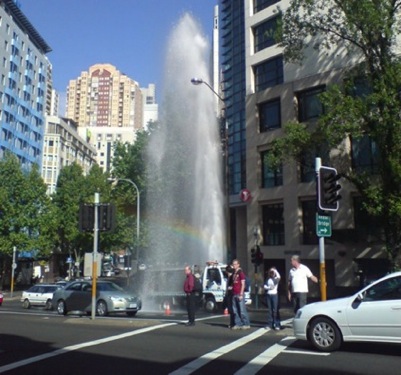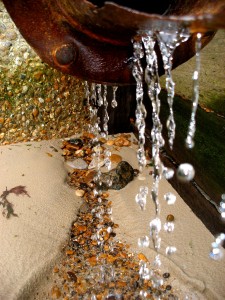
The staggering amount of water lost in the Great Lakes and nationwide is essentially only visible to the public during extreme events, like a water main break. Photo: Flickr/CC.
As your water rates creep higher, nearly six billion gallons of water that you paid to treat is lost nationwide every day.
In the Great Lakes region, leaky pipes lose 66.5 billion gallons of water annually. That’s enough to supply the yearly needs of the residents of Wyoming, Vermont and South Dakota combined — or submerge Manhattan.
And chances are, your water utility doesn’t even know.
The Center for Neighborhood Technology, an urban sustainability nonprofit organization in Chicago, recently looked at water loss nationwide and in the Great Lakes with their report, “The Case for Fixing the Leaks.”
There are several hurdles to solving the problem, said Harriet Festing, the group’s director. First, there’s the task of educating the public — and the water utilities.
“The public can’t see the problem so they aren’t arguing for it,” she said. “They’re only seeing their rates increase. And the utilities are constantly firefighting the serious leaks and having their resources stripped away, so they can’t focus on investment.”
Compiling the center’s report was a challenge, Festing said. It meant seeking data from water utilities without standardized water auditing practices — or often, no auditing practices at all.
“We’ve had to estimate some things and we don’t have as much information as we’d like. That’s what’s really concerning,” she said. “The problem is much likely bigger than what we see.”
The information that is there, though, is alarming.
Under sidewalks, miles of dilapidated pipes leak 14 percent to 18 percent of the nation’s daily water. The cost for water service in 2010 was about 90 percent more than it was in 1996 — rising much faster than inflation.
Once the public and water utilities realize the severity of water loss, Festing said, the next step is to create a standard auditing policy to compare water at its source with how much is delivered to the customer.
The good news? There’s already free assistance.
“There is free software already available from the American Water Works Association,” Festing said. “We’ve been exploring federal mandates for auditing, but the biggest issue is that most water utilities don’t know that the auditing program exists.”
Auditing works — and works well. One of the few success stories outlined in the report is that of the Philadelphia Water Department, which has audited water loss for more than 20 years. Since 2000, it has saved more than $15 million.

Once auditing indicates the source of a potential infrastructure problem like a leaky pipe, a simple acoustic test can usually pinpoint the precise area. Photo: Flickr/CC.
“Philadelphia took an interest in water loss about 20 years ago, and that’s when we started conducting auditing and developing a plan to address any problems,”
said George Kunkel, the department’s water efficiency program manager.
About half of U.S. states require water loss auditing to some degree. But without standardized definitions and programs, the data gets convoluted, according to the report.
Kunkel said his department often looks to Georgia as an example of auditing success. Tennessee and Georgia require water loss auditing from all utilities using the American Water Works Association program.
And although auditing isn’t perfect, Kunkel says, it’s still the best option.
“You’re never going to have a loss-free system,” he said. “But the important thing is to track it, have an idea of what you’re losing and focus on the losses in a targeted fashion.”
Kunkel says he also supports a federal mandate if it means utilities will start auditing quickly.
“For most water utilities, it’s going to take about three to five years to build a reliable data set,” he said. “And the longer you wait, the more problems you have with your infrastructure.”
It’s a commitment of time, effort and initial investment, but one that absolutely has to be done, said Festing.
“It makes environmental sense, business sense and public sense,” Festing said. “We’ve yet to meet with a service provider or anyone that thought solving this problem was a bad idea. It’s just about building momentum and education.”
